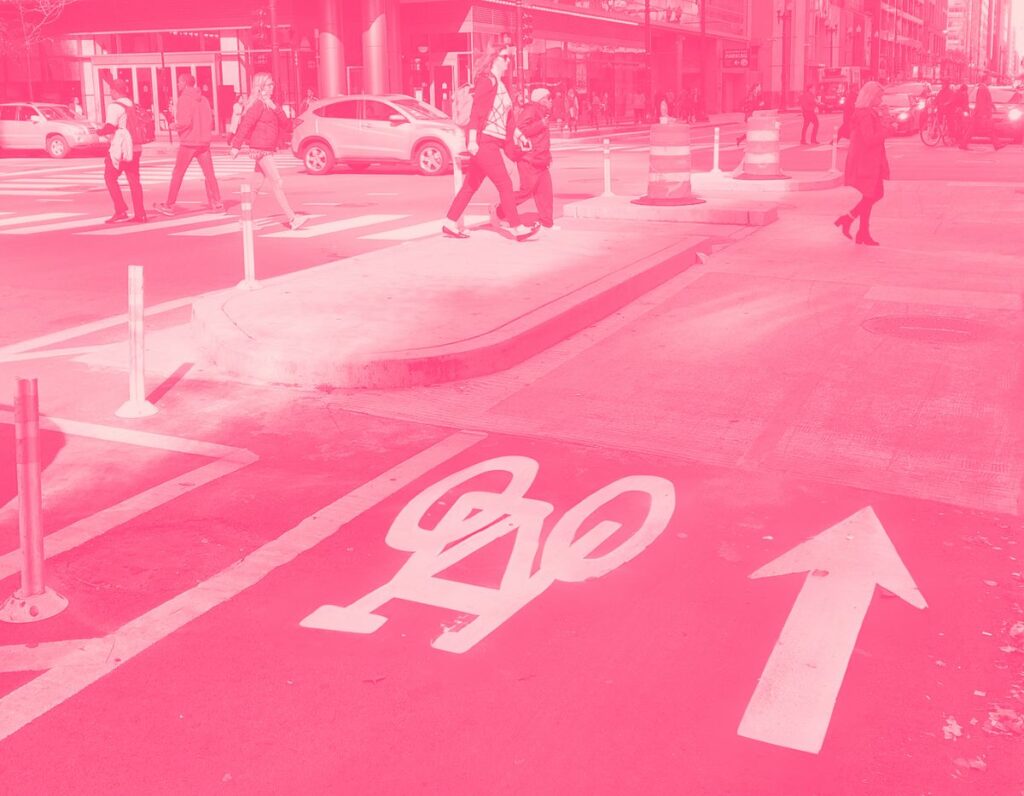Drivers kill 43,000 people in the US each year. This epidemic of killing disproportionately impacts people of color, with Black people twice as likely to be killed by a car as White people. Advocates for ending traffic violence offer two types of solutions to stop the bloodshed: redesigning our roads to be safer for all and expanding the police state. While anti-traffic-violence advocates prefer design solutions, America’s car and carceral culture makes winning more cops, cameras, fines, and incarceration politically easier. But if advocates for reforming the criminal legal system join the growing movement, collectively we can win the bigger, more just solution of redesigning our roadways to be safer for all and not just another tool of the carceral state.
Traffic violence is a basic, everyday issue for many people, so the growing movement to end traffic violence has a potential role as either a strong ally in the broader abolitionist endeavor or as a regressive force. As fatalities on our dangerous roads increase, so too will the work of advocates pushing elected officials to fix the problem. But which specific policies get implemented is still to be determined.
Carceral solutions to traffic violence
Expanded police enforcement, automated traffic enforcement cameras and mass surveillance, significantly higher fines and steeper punishments are the main carceral solutions to traffic violence. Many advocates for ending traffic violence are comfortable with carceral solutions, as it is viewed akin to the earlier and ongoing work of Mothers Against Drunk Driving, which cut drunk driving in half. After all, the reasoning goes, if fines and police enforcement was so successful at stopping dangerous driving by intoxicated people, shouldn’t we use these same tools to stop dangerous driving regardless of the state of the driver? Especially as billions of dollars in new federal funding for speed cameras roll out across communities, it may be tempting for advocates to embrace carceral solutions.
Advocates committed to addressing the criminal legal system understand that trying to stop traffic violence with mass surveillance, punitive fines, increased contact with law enforcement, and potential incarceration is a human rights disaster. Already, traffic enforcement is one of the most common civilian interactions with police, as 40% of interactions between police and adults in the US involve traffic stops. Each stop creates the potential for escalated and deadly situations like the tragic death of Sandra Bland. 10% of people killed by police were killed during a police traffic stop so significantly expanding the number of traffic stops might lower traffic violence, but it is likely to increase instances of police brutality.
A less violent, but still carceral, solution would be to replace cops with networks of cameras for traffic enforcement. However, cameras come with their own problems. “When the government has real-time and historical data about everyone’s innocuous trips, the potential for abuse is enormous,” said American Civil Liberties Union’s legal fellow Asiyahola Sankara. “Information can be cataloged and saved indefinitely, and unlawful applications—historically, targeting journalists, individuals seeking abortions, Black organizers, anti-war activists, and others—can go undetected for years.”
No matter whether a cop or a camera issues a ticket, regressive fines are still deeply punitive. For example, a speeding ticket in Texas is over $200 and increases your car insurance costs by 19%. Considering that 37% of Americans lack enough money to cover a $400 emergency expense, a single speeding ticket on a wide road can set off a cascade of financial issues, losing a license, missing work, and can lead to other interactions with the criminal legal system. Ferguson, MO is the poster child of the exploitative use of traffic fines.
Concrete abolitionist solutions to traffic violence
Fortunately, there’s another set of tools for the movement against traffic violence: “self-enforcing” street designs that prevent dangerous driving in the first place. These solutions include physically protected bike lanes, pedestrian refuge islands, bus-boarding islands, narrowing roads, converting some blocks to pedestrian-only zones, widening sidewalks, turning intersections into cul-de-sacs, and making other physical changes to roads. By separating cars from other road users, communities can lower the likelihood of collisions; by slowing cars down, they can dramatically reduce the severity of collisions.
For example, if there is a concrete curb separating a driver from a senior on a mobility chair, the driver will hit the concrete and not the senior. If drivers have to slow down to 10mph to get through a residential street that has planters in the road, then it is much easier for them to stop suddenly if needed.
Design solutions have been internationally successful, particularly in Europe where road deaths per capita are half those in the US and shrinking. They reduce traffic violence as well as improving car-free mobility options for people of a wide range of ages and ability levels in both rural and urban communities. However, they also can take more upfront capital to install (though short metal posts installed in the ground called “bollards” are surprisingly affordable and effective at stopping cars from going where they shouldn’t go). Most importantly, from a political standpoint, they usually involve removing parking or car travel lanes. Even in liberal communities like Berkeley, street safety improvements that remove parking can be politically difficult.
Most anti-traffic-violence advocates, particularly people who are already cop-skeptical due to the harm they face from police, prefer design solutions that create “self-enforcing” streets and are inherently abolitionist tools. “It’s really important to focus on infrastructure, which can actually stop bad driver behavior and keep everybody safe, instead of enforcement which in the best case only deals with bad behavior after the fact, in the average case doesn’t do anything, and in the worst case gets somebody killed by the police,” said Aditya Bhumbla an organizer of Safe Street Rebel in San Francisco.
However, as traffic violence deaths mount and more anti-traffic-violence groups form, many groups are willing to simultaneously push for both design and enforcement solutions. Each anti-traffic-violence group will have its own preference for physical design and/or carceral-based solutions, and it will largely reflect the community at large. The anti-traffic-violence groups forming in communities with existing robust justice movements will tend toward embracing design, while groups that form in less justice-oriented communities will be more comfortable with carceral solutions.
Organizing for design-based solutions
In California, “Safe Roads Save Lives,” which I am a part of, is doing just that. The coalition of justice, bike and anti-traffic-violence groups is stepping up to push back against carceral solutions, and to explicitly call for changed street design as a viable solution.
“Through traffic calming measures and other investments in infrastructure that increase traffic safety and transform community spaces, we can begin to address historical imbalances, work towards better health outcomes, create navigable, sustainable, welcoming spaces, and decrease our reliance on surveillance and police for traffic enforcement,” said coalition member Olivia Ensign, Senior Advocate and Researcher at the US Program of Human Rights Watch,
In New York and California these issues are reaching a critical point. In 2022, New York passed a law expanding speed-camera work around the clock, while in California, in 2023 Governor Newsom signed a bill introducing speed cameras in select cities. The California bill, AB 645, faced opposition from justice groups like Human Rights Watch, ACLU California Action, Anti Police-Terror Project, Black Lives Matter California, and the Electronic Frontier Foundation. They argue in their opposition letter that:
“AB 645 taxes residents harmed by racist infrastructure decisions to fix roads. Many of our most dangerous roads are in minority neighborhoods due to the historic role of racism in infrastructure decisions. Rather than requiring that cities fix the issue, AB 645 instead transfers the cost to those most affected by authorizing speed traps using automated ticketing on these poorly designed roads to pay for the traffic calming fixes somewhere in the city – not even guaranteeing a fix where speeding problems are worst.”
These leading justice groups are not just calling for a rejection of carceral solutions to traffic violence, but are actively working to promote self-enforcing street design locally. For example, Anti Police-Terror Project, based in Oakland, recently partnered with a group I volunteer with, Traffic Violence Rapid Response, on a campaign to get $20 million in funds redirected from the Oakland Police Department to Oakland’s Department of Transportation for street safety infrastructure. The campaign won a $3 million increase in the Transportation Department’s budget, though the Oakland Police Department also received over $40 million in increased funding.
Across the county, local and state-wide bike advocacy groups are some of the loudest organized voices for design solutions to traffic violence, such as protected bike lanes. Many bike advocates and justice advocates are already collaborating for design solutions in part because the bike advocates are often justice advocates (and vice versa). There is also a complicated history of bike lanes both as tools of mobility justice and of gentrification, so justice and bike advocates tend to have a history together. These groups are primed to collaborate on design solutions that reduce interactions with police as well as traffic violence.
Roadblocks to traffic safety
Car dominance, white supremacy and police power in America are so pervasive that it is generally more politically feasible to get speed cameras and cop cars along a dangerously wide road than it is to get the road redesigned to be safer. For example, my city of Oakland, California is facing an epidemic of traffic violence and Governor Newsom responded by sending Highway Patrol Officers and automatic license plate readers – he did not send emergency funding and engineering teams so that the city could redesign the roads to fundamentally be safer.
Entrenched American police and car culture will make the carceral toolset much more likely to get implemented than road design. While the street safety movement gains momentum and continues to define itself, justice advocates can seize the moment to win over a crucial and strengthening ally. Self-enforcing streets are an innocuous-seeming tool of police abolitionists. We can win them if we work together.
Solidarity is the road to true safety
Fortunately, justice advocates can bring two essential items to the table that can help move street safety advocates towards focusing on design solutions.
The first tool we bring is statistics and stories. There is still academic debate over the effectiveness of networks of red light and automatic speed cameras that issue fines to drivers. Some traffic safety advocates argue that the fines and other penalties have not been stringent enough to deter dangerous drivers, but experienced criminal legal system advocates know that fines and over-policing are not just questionable but also abusive. By continuing their messaging and outreach work, they can help safe streets advocates learn that communities cannot punish their way to safety.
The second is political power. The street safety movement can win design and carceral solutions in local battles here and there. But winning statewide policy shifts on street design is a massive lift and we’ve already gotten a glimpse of what will happen if these movements cannot muster enough collective political power. In 2019, Governor Gavin Newsom vetoed a “Complete Streets” bill, while in 2023 he signed a law expanding automatic traffic enforcement.
As local and state street safety groups like Vision Zero Network and Families for Safe Streets continue to grow their mobilization efforts to stop traffic violence, it will be increasingly important for them and justice advocates to intentionally build coalitions to fight for concrete solutions that work for everyone. Working together, we can take on America’s dangerous car and carceral culture and win design-based/abolitionist policies that make America’s deadly roadways safer for all.
Featured image: Corner islands for protected bike lanes (Chicago, 2017). Photo by Eric Fischer, licensed CC BY 2.0 via Wikimedia Commons.
Did you enjoy this article?
We're in the middle of our annual fund drive, and this year we're building our own internal infrastructure for subscriptions, meaning more of every dollar pledged goes to fulfilling our mission. Subscribe today to support our work and be a part of Convergence's next evolution.

